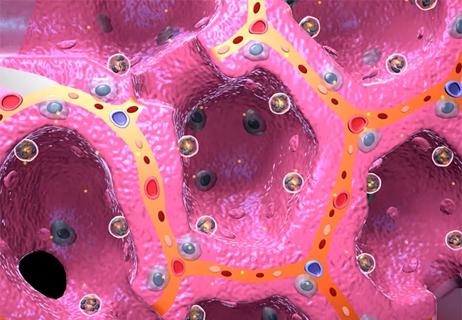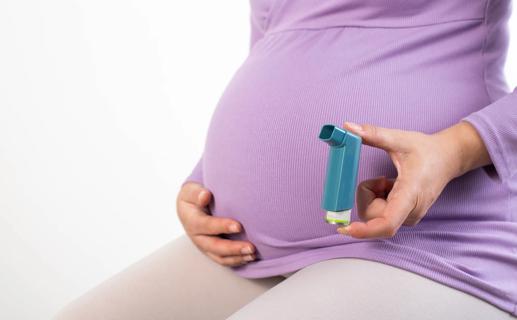Endoscopic balloon dilation during pregnancy helps optimize outcomes

Subglottic stenosis is a rare but life-threatening condition that can be particularly dangerous among pregnant patients. The condition, often associated with cough, progressive hoarseness and dyspnea can be misdiagnosed due to its symptomatic similarity to asthma. But for a patient who is struggling to breathe during labor, the increased fatigue can weaken the patient and cause trouble with delivering the fetus. However, when the condition is diagnosed early in pregnancy, there is a tendency toward surgical intervention to ensure that the mother can labor safely.
Advertisement
Cleveland Clinic is a non-profit academic medical center. Advertising on our site helps support our mission. We do not endorse non-Cleveland Clinic products or services. Policy
While there is not presently an official recommendation for airway stenosis management in pregnant patients, new research appearing in Laryngoscope looked at the current approaches for surgical management. The researchers looked at the various surgical options, surgical considerations to optimize maternal and fetal care, and the outcomes of patients who underwent surgical management.
“In our study, we looked at 15 articles and a total of 27 patients who had received surgical intervention for subglottic stenosis during pregnancy,” explains Paul Bryson, MD, MBA, Director of the Cleveland Clinic Voice Center and Section Head of Laryngology and senior author on the article. “The associated symptoms of subglottic stenosis are often progressive and relatively slow in manifesting, so we had an interest in trying to determine which procedures can be safely done and when during a pregnancy.”
Also involved with the study are Katherine M. Miller, MD; Kevin Y. Liang, MD; Neil Nero, MLIS; Michael S. Benninger, MD; Rebecca C. Nelson, MD; William S. Tierney, MD and Robert R. Lorenz, MD, MBA.
The 15 included studies were published between 1963 and 2022, and they came from five countries. The 27 participants from the 15 studies had a median age of 29 years (range, 20-40 years), a median gestation age intervention of 28 weeks and an average Cotton-Myer grade of III. The Cotton-Myer classification system is a tool to evaluate the severity of subglottic stenosis, with grade I as the least obstructed and grade IV being completely obstructed. Among the participants, the most common etiology of airway stenosis was idiopathic (11/27), autoimmune (4/27), iatragenic (1/27) and rheumatologic (1/27).
Advertisement
The researchers noted that the most common procedure from the review was direct laryngoscopy (DL) and balloon dilation with or without lysis of scar tissue (85.1% dilation vs. 14.9% other). Dilation was held between 20 and 60 seconds and was repeated up to five times. In patients where lysis was performed, laser was the most common modality, and a CO2 laser was used in 11 cases. Other options for lysis included microlaryngeal scissors and an electrocautery knife. In three patients, tracheostomy was performed as the primary management in two cases. The majority of patients only required one surgical intervention during their pregnancy. The median length of time for the surgical procedures was 25 minutes (range: 13 – 90 minutes).
“The most common technique in managing subglottic stenosis is the mucosal sparring technique, which is a relatively less invasive approach that involves radial incisions and light dilatation, but since we included articles from 1963, there were a few techniques that have since fallen out of favor, such as the Nd-yag laser and electrocautery knife,” says Dr. Bryson. “One technique that is still widely used with these procedures is the injection of steroids into the lesion. There have not been any studies that specifically examined the outcomes of intralesional steroid injection of the larynx in pregnant persons. Still, the use of intralesional steroid to the breast is a known practice used in pregnant women with idiopathic granulomatous mastitis.”
All but one of the 15 studies reported ventilation methods during their respective interventions. Fourteen women were managed with jet ventilation, and nine women were managed with transnasal humidified rapid insufflation ventilatory exchange (THRIVE). Both ventilation methods were used without incident, and none of the studies reported the need to change ventilation methods or loss of airway during the procedure. In the studies that reported positioning, the left lateral position with 30˚ reverse Trendelenburg was most commonly used. The studies also reported 21 fetuses were monitored intraoperatively using fetal heart monitoring (FHM). In the six cases where FHM was not used, it was because of the pre-viability of the fetus. Sonograms were not used during any of the procedures.
Advertisement
Regarding maternal-fetal outcomes, 14 births were vaginal, and the other eight were cesarian section. All but three of the infants were delivered at term. The median time from last procedure to delivery was 10.3 weeks (five days – 31 weeks). Infant health was reported for 16 of the patients. Three infants required admission to the neonatal intensive care unit after birth. One required intubation due to respiratory depression after benzodiazepine was used to alleviate maternal seizures, and another required resuscitation for apnea but was not intubated. One infant was hospitalized for low birth weight at 34 weeks, but the hospital stay was uncomplicated.
Some maternal pregnancy-related complications were also reported. One patient post-laser laryngeal edema in a patient with granulomatosis with polyangiitis who underwent a laser resection at 30 weeks. The patient was hospitalized for monitoring and ultimately developed preeclampsia at 32 weeks, which required an emergency cesarian section. Another patient with dyspnea had to return to the operating room for debridement of laryngeal crusting after undergoing direct laryngoscopy with CO2 laser lysis of scar band and balloon dilation at 15 weeks. In regard to timing, the review indicated that second and third trimesters appear to be safe for airway intervention, and the researchers noted that very few patients who needed repeat interventions.
“We felt this retrospective study was important because of the hesitancy associated with performing procedures on pregnant persons,” explains Dr. Bryson. “This hesitancy means there aren’t very many strong prospective or retrospective studies which limited the number of patients and studies we could include. However, ACOG released guidelines to help clinicians with their decision-making when it comes to performing surgeries.”
Advertisement
The organization notes that while there isn’t any evidence that in utero exposure to anaesthetic or sedative drugs doesn’t have any teratogenic or neurological impact as long as exposure is less than three hours. With the longest procedure lasting 90 minutes, laryngeal and tracheal surgeries can be viewed as safe according to these guidelines. Additionally, ACOG also recommended using fetal heart monitoring and positioning the mother in a left lateral recumbent position when possible.
“While our review suggests that endoscopic balloon dilation during pregnancy is safe and effective, it’s important for clinicians to communicate with their patients to facilitate more informed decisions for both patients and providers,” says Dr. Bryson. “Early consultation and communication with anesthesiology and maternal/fetal medicine colleagues is also important. Because of the small number of published trials on the topic and otolaryngologic descriptions of procedures, our review did have some limitations. Therefore, more research is needed to fully determine the safety and effectiveness of subglottic stenosis airway management during pregnancy.”
Advertisement
Advertisement

Case study illustrates the potential of a dual-subspecialist approach

New tools and protocols to improve care

Surgery is typically the only option for the most severe cases, but a minimally invasive procedure is reducing morbidity and recovery time for patients

Cleveland Clinic pulmonologists share a framework for how to implement effective clinical protocols to standardize evaluation and management of complex acute respiratory distress syndrome

A public health tragedy with persistent pathophysiological and therapeutic challenges

Prescribing eye drops is complicated by unknown risk of fetotoxicity and lack of clinical evidence

Research may offer family-planning insights for those with the condition

Largest study examines factors affecting asthma exacerbations during and after pregnancy